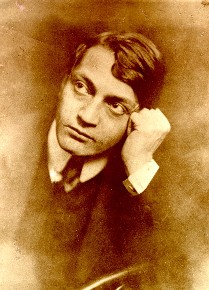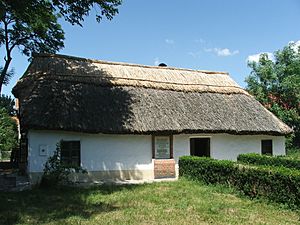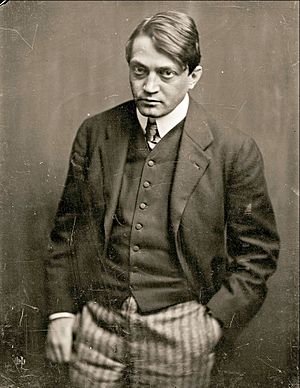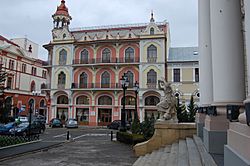Endre Ady facts for kids
Endre Ady (born November 22, 1877 – died January 27, 1919) was a famous Hungarian poet and journalist from the early 1900s. Many people think he was the most important Hungarian poet of the 20th century. He believed strongly in making society better and more modern. His poems explored big ideas like love, time, faith, being an individual, and love for one's country.
Contents
Life Story of Endre Ady
Endre Ady was born in a village called Érmindszent. This village was part of Austria-Hungary at the time. Today, it is in Romania and is called Ady Endre. His family was noble but not very rich, and they followed the Calvinist faith. Endre was the second of three children. His older sister, Ilona, died when she was very young. The writer and poet Mariska Ady was his niece.
Early Education and First Poems
From 1892 to 1896, Ady went to the Calvinist College in Zilah. This town is now called Zalău in Romania. On March 22, 1896, he published his very first poem. It appeared in a local newspaper called Szilágy.
After college, he started studying law at the Reformed College in Debrecen. However, he left school before finishing his degree. He then decided to become a journalist. In 1899, he published his first collection of poems, called Versek (which means Poems).
Moving to Nagyvárad and Meeting Léda
Ady soon grew tired of Debrecen. He felt the town was old-fashioned, and he even wrote about this feeling in his later poems. He moved to Nagyvárad, a city that had a lively cultural scene. In 1902, he wrote articles for the local newspaper Nagyváradi Napló. In these articles, he paid close attention to the social issues of his time.
Working as a journalist and spending time with other creative people helped him grow. In 1903, he published another collection of poems. However, he was still not very well known. His life changed in August 1903 when he met Adél Brüll Diósy. She was a wealthy, married woman who lived in Paris but was visiting her home in Nagyvárad.
Ady called her Léda in his poems. She became his inspiration. His love for her, and their trips to Paris, helped him develop his writing talent. He visited Paris seven times between 1904 and 1911. After his first visit, which lasted a year, he moved to Budapest. There, he started working for the newspaper Budapesti Napló. He published more than 500 articles and many poems there.
Success and New Directions
Ady was interested in politics and joined a group called Huszadik Század (Twentieth Century). In 1906, he published his third poetry book, Új versek (New Poems). This book was a very important moment in Hungarian literature. It marked the beginning of modern Hungarian poetry. His fourth collection, Vér és arany (Blood and Gold), brought him real success and praise from critics.
In 1906, Ady decided to leave Hungary and went to Paris again. In 1907, he had to leave his job at Budapesti Napló.
In 1908, a new magazine called Nyugat (The West) published one of his poems and an essay. He continued to work for this magazine for the rest of his life. From 1912, he even became one of its editors. Also in 1908, he helped start a literary group in Nagyvárad called A Holnap (Tomorrow). This group published a collection of poems by Ady and other poets.
Some people did not like the poems in this collection. Ady was also criticized for a poem where he seemed to be unpatriotic. In this poem, he showed the difference between the rich cultural life he wanted and the difficult lives of Hungarian peasants. Ady did not like it when other poets tried to copy his style. He even wrote a short story making fun of them.
Political Views and Personal Life Changes
Ady was a main writer and leader for Nyugat, an important Hungarian literary magazine. He also wrote political articles for other magazines. He often criticized the political situation in Hungary at the time. He did not like the strong nationalism of some political parties. However, he also criticized those who were against nationalism. He knew that Hungary was behind more developed countries. But he also saw the problems in Western countries.
From 1909, Ady often needed medical treatment for his health. The political situation in Hungary became difficult. Workers were protesting against the government. Ady felt that a revolution was coming. His personal life was also going through a tough time. His relationship with Léda became harder and harder. As Ady became a very famous poet, Léda's role in their relationship changed. He broke up with her in April 1912.
In 1914, he met Berta Boncza, who was 20 years old. They had been writing letters to each other since 1911. In 1915, they got married, even though her father did not approve. In his poems, Ady called her "Csinszka."
Ady's Final Years
After Archduke Franz Ferdinand was killed in 1914, Ady felt that a war was about to begin. Everyone he knew seemed excited about the war. But Ady was left alone with his fears and worries about the future.
He published his last book of poetry in 1918. He was very sick when he wrote his final poem, "Üdvözlet a győzőnek" (Greetings to the victor). He was chosen to be the president of the Vörösmarty Academy, a group of modern writers. However, he was too ill to give his opening speech. Endre Ady died in Budapest on January 27, 1919. He was buried in the Kerepesi Cemetery in the city.
Understanding Ady's Poetry
At the beginning of the 20th century, many Hungarian poets tried to write in a folk-like style, similar to Sándor Petőfi. But most of them lacked Petőfi's unique vision. Their style did not feel new or fresh. Ady was the first poet to break away from this old tradition and create a modern style.
He liked to see himself as a lonely, misunderstood revolutionary. However, most poets of his time supported him, and many even tried to copy his style. His first two poetry books did not show anything new. He was still influenced by 19th-century poets like Petőfi. The first signs of his own unique style appeared in his essays and other writings, not yet in his poems.
Ady was definitely influenced by the works of French poets like Baudelaire and Verlaine. He often used a technique called Symbolism. This means he used symbols to represent ideas. His poems often explored themes like God, Hungarian identity, and the struggle to survive in modern society. Other themes, like money, life and death, and his relationship with Léda, appeared in different periods of his life.
List of Ady's Works
- Versek ("Poems", 1899)
- Még egyszer ("Once Again", 1903)
- Új versek ("New Poems", 1906)
- Vér és arany ("Blood and Gold", 1907)
- Az Illés szekerén ("On Elijah's Chariot", 1909)
- Szeretném, ha szeretnének ("I'd Love to Be Loved" 1910)
- A Minden-Titkok versei ("The Poems of All Secrets", 1911)
- A menekülő Élet ("The Fleeing Life", 1912)
- Margita élni akar ("Margita Wants to Live", 1912)
- A magunk szerelme ("Our Own Love", 1913)
- Ki látott engem? ("Who Have Seen Me?", 1914)
- A halottak élén ("Leading the Dead", 1918)
- Az utolsó hajók ("The Last Ships", 1923)
Honors and Recognition
Hungary has honored Endre Ady in several ways. A postage stamp with his picture was released on March 15, 1947. This was part of a series honoring Hungarian freedom-fighters. From 1969 to 1990, his image appeared on the 500 forint banknotes. Another stamp was issued on January 27, 1969, for the 50th anniversary of his death. On November 22, 1977, for his 100th birthday, another stamp and a small sheet of stamps were released.
Romania also honored him with a commemorative postage stamp on December 5, 1957. This was for the 80th anniversary of his birth.
In 1984, a statue of Ady, made by Geza Csorba, was placed in the courtyard of Innis College in Toronto, Canada.
See also
 In Spanish: Endre Ady para niños
In Spanish: Endre Ady para niños





